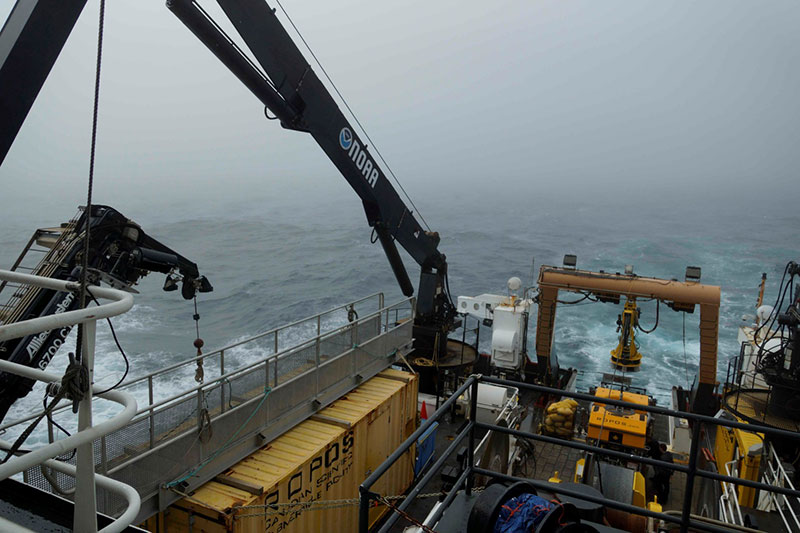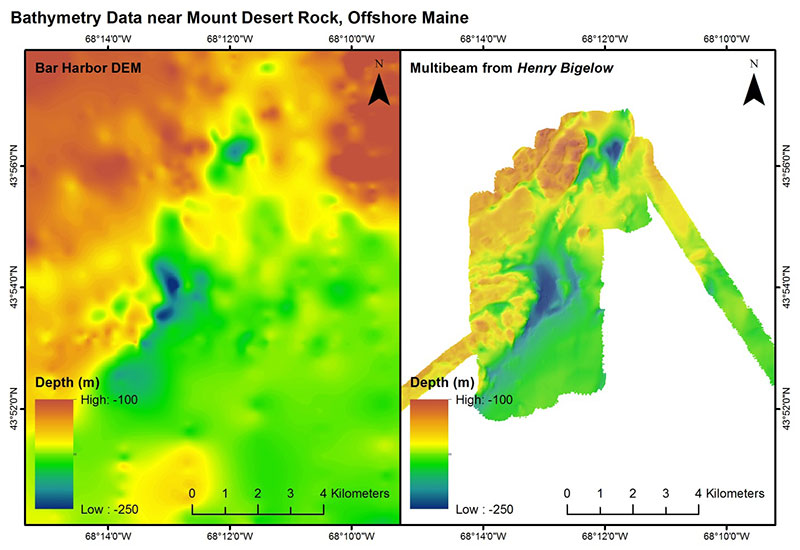
by Dr. Martha Nizinski, Zoologist, NOAA Office of Science and Technology, National Systematics Laboratory
June 19, 2017

Rough seas and winds in the Gulf of Maine bring remotely operated vehicle operations to a halt. Image courtesy of Peter Lawton. Download larger version (jpg, 706 KB).
Chief Scientists’ weather report: Foggy, seas 5-7 feet, building into a crescendo of seafloor mapping.
Last night our remotely operated vehicle (ROV) operations came to an end earlier than planned due to building seas caused by increasing wave height and strong winds.
Out here, weather is a factor in everything we do. ROPOS has a weather window for operations—conditions when it is safe to deploy the ROV. Once conditions deteriorate to sustained winds of 25 knots and wave height of seven feet, launching a 7,481-pound ROV is simply not safe for the crew or the equipment.
We shifted operations towards less exciting, but still essential, activities including cleaning up the wet lab, tying down equipment and storage totes, and storing samples in safe places. It’s always a good idea to make sure that everything is secure and won’t fall off work benches or scatter over the deck. We don’t want anyone to get hurt or anything to happen to our samples!
So on to Plan B. Even though we can’t use the ROPOS ROV in these rough seas, the conditions out here are still favorable for multibeam mapping. Multibeam is a type of sonar that emits sound waves. The amount of time it takes for the sound waves to bounce off the seabed and return to the receiver is used to determine water depth and as a result helps define features on the seafloor. Believe it or not, there are still many parts of the Gulf of Maine, a well-known body of water, where we still have no information on the topography of the seafloor.

Multibeam bathymetric maps of the seafloor near Mount Desert Rock in the Gulf of Maine, an area that has known coral gardens. Map on the left is an older multibeam map of the area; the higher-resolution, more detailed map on the right is the result of the latest multibeam mapping by the Bigelow. Warmer colors (reds) indicate higher topographic relief (shallower depths, and often an indication of hard bottom), colder colors (blue) indicate lower topographical relief (deeper depths, and often an indication of soft or muddy bottoms). Deep-sea corals gardens in the Gulf of Maine tend to be found in areas of higher topographic relief. Image courtesy of Northern Neighbors: Transboundary Exploration of Deepwater Communities. Download larger version (jpg, 570 KB).
Having high-quality maps of the seafloor that show bathymetry, outlines of features on the bottom, and the slope of those features provides clues on where we might find deep-sea corals based on their habitat requirements. The Gulf of Maine is a big area and by comparison, prime coral habitat is small. Thus having some guidance on where to sample increases our likelihood of finding features with characteristics that suggest good habitat for corals. Choosing these sites as potential dive locations in conjunction with results from a habitat suitability model maximizes our ROV dive time.
Although we would rather be looking at images of the seafloor, we are still collecting highly precise and therefore extremely valuable mapping data. Scientists are using this downtime to inventory their sample collections, prepare spreadsheets, and organize information. When at sea, you learn early on that you have to be flexible and roll with the waves. You always need to have back-up plans to make sure that your precious time at sea is not wasted.